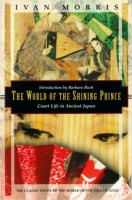 Author: Ivan Morris
Author: Ivan Morris
Publisher: Kodansha
ISBN: 9781568360294
Released: June 1994
Original release: 1964
Several years ago I read the entirety of The Tale of Genji, a novel written by Murasaki Shikibu in the eleventh century. It was a pretty big undertaking, but absolutely worth it. I love the novel. Ever since finishing The Tale of Genji for the first time, I’ve been meaning to read Ivan Morris’ The World of the Shining Prince: Court Life in Ancient Japan. The volume takes its title from the hero of The Tale of Genji who is referred to as the shining prince due to his exquisite visage and exceptional character. In many ways, The World of the Shining Prince serves as a companion to The Tale of Genji as Morris explores the historical reality of the aristocracy of Heian-era Japan. The World of the Shining Prince was originally published in 1964. Beginning in 1994, later editions of the work also include an introduction by Barbara Ruch. I recently read and was rather impressed by another of Morris’ works, The Nobility of Failure: Tragic Heroes in the History of Japan, and so was looking forward to reading The World of the Shining Prince even more.
In addition to the introductions, preface, appendices, bibliography, and topical index, The World of the Shining Prince examines a number of different aspects of tenth-century Japan, Heian court society, and The Tale of Genji within it ten chapters. Morris begins with a broad overview of the era in the first chapter, “The Heian Period.” Though the Heian Period lasted from 782 to 1167, The World of the Shining Prince largely, but not exclusively, focuses on the 900s. The next chapter, “The Setting” looks at Heian architecture, city planning, and geography. From there Morris delves into more detailed analysis of Heian culture in the chapters “Politics and Society,” “Religions,” and “Superstitions.” Next, attention is specifically turned to the Heian nobility and aristocracy. “The Good People and Their Lives” details day-to-day activities, amusements, and ceremonies while “The Cult of Beauty” looks at the particular aesthetics of the era. The eighth chapter, “The Women of Heian and their Relations with Men” outlines household and family structures as well as the place of romantic liaisons. The World of the Shining Prince concludes with chapters devoted to Murasaki Shikibu and to The Tale of Genji itself.
Although written more than five decades ago, The World of the Shining Prince has held up remarkably well. Admittedly, it is nearly impossible to write a completely objective cultural study–Morris’ analysis is informed and influenced by his own cultural subjectivity. In the half-century since The World of the Shining Prince was written, Western thought and scholarly approaches to cultural analysis have also changed. (For example, as Ruch mentions in her introduction, views on gender politics and the relationship between religion and superstition has shifted over the years.) The World of the Shining Prince is a product of its time, but that doesn’t at all diminish its value as a resource on Heian-era Japan, and more specifically on Japanese court life in the tenth century. Additionally, the volume is written with a general audience in mind. It is quite approachable, even for the average reader, and is engagingly written. Granted, the subject mater of The World of the Shining Prince is fascinating to being with.
Although Morris does provide some important general context within which he situates The World of the Shining Prince, the volume’s scope is relatively narrow, concentrating on a very specific part of Heian society. However, this specificity also allows him to explore that subject from several different perspectives. Information about the Heian Period is somewhat limited, especially in regards to the lower classes, which is another reason that The World of the Shining Prince is so focused on the era’s nobility. The Tale of Genji is a major source for Morris’ study of the Heian-era Japan, as are other works of contemporary literature–The Pillow Book of Sei Shōnagon especially features prominently–as well as diaries and court records from the time period. The World of the Shining Prince is an extremely informative and absorbing work. It’s more than just a companion to The Tale of Genji and reaches beyond its literary connections. The volume should appeal to anyone interested in learning more about classical Japanese history.